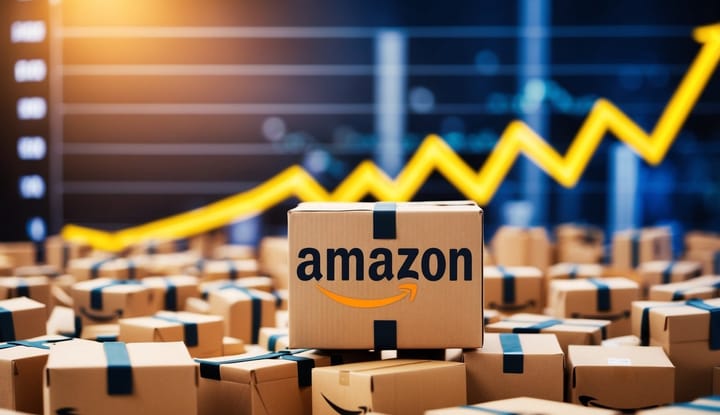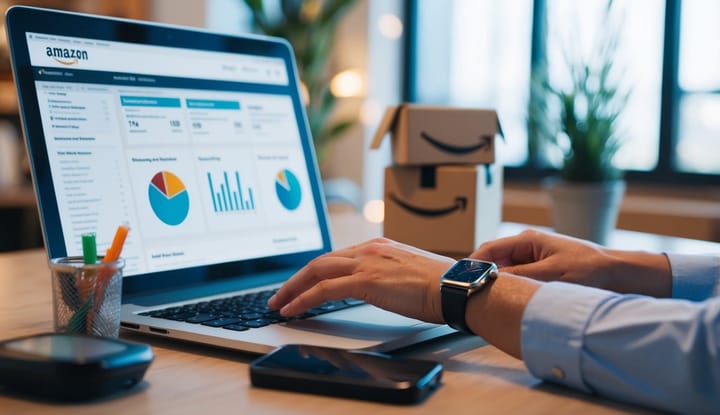Amazon FBA vs FBM: Which is Best for Your Amazon Business?

Selling on Amazon offers two main fulfillment options: Fulfillment by Amazon (FBA) and Fulfillment by Merchant (FBM). These choices shape how sellers manage their inventory and deliver products to customers. Most Amazon sellers (82%) use FBA, while a smaller portion (34%) use FBM.
FBA lets Amazon handle storage, shipping, and customer service. Sellers send products to Amazon warehouses, and the company takes care of the rest. FBM, on the other hand, puts sellers in charge of storing and shipping items themselves. Each method has its own costs, benefits, and challenges.
Choosing between FBA and FBM affects product visibility, Prime eligibility, and the chance to win the Buy Box. FBA items often get more exposure and are more likely to be chosen by shoppers. But FBM can work well for certain products or business models. Sellers must weigh these factors to pick the best option for their needs.
Key Takeaways
- FBA and FBM offer different levels of control over fulfillment and customer service
- Costs, product type, and sales volume influence the choice between FBA and FBM
- The fulfillment method impacts product visibility and competitiveness on Amazon
Understanding Amazon Selling Models
Amazon offers two main fulfillment options for sellers: Fulfillment by Amazon (FBA) and Fulfillment by Merchant (FBM). Each model has unique features that impact sellers' operations and success.
Key Differences Between FBA and FBM
FBA allows sellers to store products in Amazon's warehouses. Amazon handles shipping, customer service, and returns. This model is popular among sellers who want to focus on product sourcing and marketing.
FBM requires sellers to manage their own inventory and shipping. Sellers store products in their own facilities and handle all aspects of order fulfillment. This model gives sellers more control over their operations.
FBA sellers often see higher sales due to Prime eligibility. FBM sellers have more flexibility in pricing and inventory management. The choice between FBA and FBM can greatly impact a seller's profit margins and growth potential.
Pros and Cons of FBA and FBM
- Prime badge increases visibility
- Amazon handles storage and shipping
- Access to Amazon's customer service
FBA cons:
- Higher fees
- Less control over inventory
- Potential for long-term storage fees
FBM pros:
- Lower fees
- More control over inventory and shipping
- Ability to offer unique products
FBM cons:
- No Prime badge (unless seller qualifies for Seller Fulfilled Prime)
- Responsibility for all aspects of fulfillment
- May be harder to win the Buy Box
Sellers often choose FBA for convenience and scalability. FBM can be better for sellers with unique products or those who want to maintain their brand identity. Some sellers use both models, adapting their strategy based on product characteristics and market conditions.
Costs and Fees Associated with FBA and FBM
Amazon sellers face different costs and fees depending on whether they choose Fulfillment by Amazon (FBA) or Fulfillment by Merchant (FBM). These fees impact profit margins and affect which method works best for different types of products and businesses.
Breakdown of FBA Fees
FBA sellers pay several fees to Amazon for storing and shipping their products. The main FBA fees include:
- Fulfillment fees: Cover picking, packing, and shipping orders
- Storage fees: Charged monthly based on inventory volume
- Referral fees: Typically 15% of the sale price for most categories
- Long-term storage fees: For items stored over 365 days
FBA fees vary based on product size, weight, and category. Smaller, lighter items usually have lower fees.
Here's a simple fee example for a $20 small standard-size item:
- Fulfillment fee: $3.22
- Monthly storage: $0.15
- Referral fee: $3.00
- Total fees: $6.37
Understanding FBM Costs
FBM sellers handle their own storage, packing, and shipping. Main FBM costs include:
- Warehouse space rental
- Packing materials
- Shipping costs
- Labor for order processing
FBM sellers still pay referral fees to Amazon, usually 15% of the sale price. They avoid FBA fees but take on more work and responsibility.
The costs for FBM can vary widely based on a seller's setup. A home-based seller may have low overhead, while a larger operation renting warehouse space will face higher costs.
Long-Term Storage Fees
Amazon charges extra fees for items stored in their warehouses for long periods. These fees encourage sellers to manage inventory efficiently.
Long-term storage fees apply to items stored for over 365 days. The fees are:
- $6.90 per cubic foot or $0.15 per unit (whichever is greater)
These fees are charged in addition to regular monthly storage fees. They can add up quickly for slow-moving inventory.
Sellers can avoid these fees by:
- Removing old inventory
- Offering sales or promotions
- Improving product listings
Comparing Fulfillment Fees
FBA and FBM have different fee structures that impact profits. Here's a comparison:
FBA Pros:
- Prime eligibility boosts sales
- Amazon handles shipping and returns
- Can be cheaper for small, light items
FBA Cons:
- Higher fees eat into profits
- Less control over inventory
FBM Pros:
- More control over fulfillment
- Can be cheaper for large or heavy items
- No storage fees
FBM Cons:
- More work for the seller
- May lose sales without Prime badge
The best choice depends on product type, sales volume, and seller resources. Many sellers use both methods for different products.
Optimizing Logistics and Fulfillment
Sellers on Amazon must choose the right fulfillment method and fine-tune their logistics to succeed. Both FBA and FBM offer ways to streamline operations and please customers.
Enhancing Customer Experience with FBA
FBA gives sellers access to Amazon's vast logistics network. This means faster shipping for buyers. Many FBA items qualify for Prime, which attracts more customers.
FBA handles storage, packing, and shipping. This frees up sellers to focus on other parts of their business. It also means fewer customer service issues to deal with.
Returns are easier with FBA. Amazon takes care of the whole process. This makes buyers more likely to purchase, knowing returns will be simple.
Logistics of FBM
FBM sellers manage their own shipping. This gives them more control over the process. They can choose their preferred carriers and shipping methods.
FBM allows sellers to offer personalized packaging. This can help build brand identity. It also lets sellers include marketing materials with orders.
Sellers must ensure quick and accurate order fulfillment. This is key to keeping customers happy and maintaining good seller metrics on Amazon.
FBM can be cheaper for some products. This is often true for large or heavy items that are costly to ship to Amazon warehouses.
Inventory Management Best Practices
Good inventory management is crucial for both FBA and FBM sellers. It helps avoid stockouts and excess inventory.
Use software to track stock levels and sales trends. This helps predict demand and plan restocking.
For FBA, watch storage fees closely. Remove slow-moving items to cut costs. Consider using FBM for products with unpredictable demand.
FBM sellers need enough space to store inventory. They must also be able to quickly pick, pack, and ship orders.
Keep a close eye on inventory turnover rate. Aim to balance having enough stock with avoiding excess capital tied up in inventory.
Navigating Amazon Prime and the Buy Box

Amazon Prime and the Buy Box play key roles in selling success on the platform. Sellers need to understand how these features impact visibility and sales.
The Impact of Prime Eligibility
Prime eligibility boosts product appeal to many Amazon shoppers. Prime members expect fast, free shipping on eligible items. FBA products automatically qualify for Prime. FBM sellers can join Seller-Fulfilled Prime if they meet strict requirements.
Prime products often get more visibility in search results. They may appear higher in rankings or with a Prime badge. This can lead to more clicks and sales.
Non-Prime listings may struggle to compete. Many buyers filter search results to show only Prime items. This can leave non-Prime products unseen by a large segment of shoppers.
Strategies to Win the Buy Box
The Buy Box is the "Add to Cart" button on product pages. Winning it is crucial for sales. Multiple factors affect Buy Box eligibility and placement.
Price is important but not the only factor. Amazon considers seller metrics like shipping speed and feedback scores. FBA sellers often have an edge due to Amazon's trust in its own fulfillment.
Keeping items in stock is vital. Running out can hurt Buy Box chances. Sellers should monitor inventory levels closely.
Offering competitive shipping options helps. Fast, free shipping appeals to buyers and Amazon's algorithms. FBA handles this automatically. FBM sellers need to match these standards to compete.
Support and Customer Service in FBA and FBM

FBA and FBM offer different approaches to customer support and service. Each method has its own strengths and challenges when it comes to handling customer issues, returns, and feedback.
Leveraging Amazon's Customer Support
FBA sellers benefit from Amazon's customer service team. Amazon handles buyer questions, concerns, and issues for FBA products. This frees up time for sellers to focus on other aspects of their business. FBA also includes Amazon's trusted shipping and delivery services.
FBM sellers manage their own customer support. They answer buyer questions directly and deal with shipping problems themselves. This gives more control but takes more time and effort. FBM sellers can use Amazon's messaging system to communicate with buyers.
Managing Returns and Feedback
FBA simplifies the returns process. Amazon handles returns, refunds, and restocking for FBA items. This can lead to faster resolution times for customers. FBA products are often eligible for Prime shipping, which may boost sales and customer satisfaction.
FBM sellers process their own returns. They set return policies and handle refunds themselves. This allows for more flexibility but requires more work. FBM sellers need to carefully track inventory and manage the logistics of returned items.
Both FBA and FBM sellers should monitor customer feedback closely. Prompt responses to negative feedback can help maintain a good seller rating. FBA may have an edge in feedback, as Amazon's efficient shipping and customer service can lead to more positive reviews.
Frequently Asked Questions
Sellers often have questions about the differences between Amazon FBA and FBM. These key points cover costs, fees, flexibility, advantages, competition, and commission rates.
What are the key differences in costs between Amazon FBA and FBM?
FBA sellers pay storage and fulfillment fees to Amazon. These costs cover warehouse space, picking, packing, and shipping.
FBM sellers handle their own storage and shipping. They pay for their own warehouse space and shipping materials.
How do fees compare for sellers using Amazon FBA versus FBM?
FBA fees include storage costs and fulfillment fees. These vary based on product size and weight.
FBM sellers don't pay these fees to Amazon. But they must cover their own storage and shipping expenses.
Can sellers use both FBA and FBM simultaneously on Amazon?
Yes, sellers can use both methods at the same time. This is called a hybrid approach.
Some sellers use FBA for fast-moving items and FBM for slower-selling products. This helps manage costs and inventory.
What are the advantages and disadvantages of choosing FBA over FBM?
FBA advantages include Prime eligibility and faster shipping. Amazon handles customer service and returns.
Disadvantages include higher fees and less control over inventory. FBA also requires proper product prep and labeling.
How do fulfillment methods impact seller competition on Amazon?
FBA products often rank higher in search results. They're eligible for Prime shipping, which many customers prefer.
FBM sellers may struggle to compete on shipping speed. But they have more control over their inventory and costs.
What percentage of sales does Amazon take as a fee for FBM sellers?
Amazon takes a referral fee for all sales, including FBM. This fee is typically 15% for most categories.
FBM sellers don't pay additional FBA fees. But they must cover their own fulfillment costs.
FBA or FBM—Which One Fits Your Amazon Business Best?
Join our mini-course at WAH Academy to understand the key differences and choose the right fulfillment method for your goals.
No fluff. Just clear, expert advice.
Tap below to get started.



